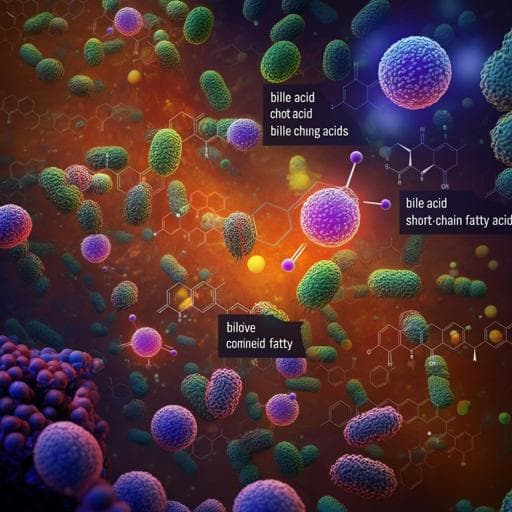
Medicine and Health
Distinct signatures of gut microbiome and metabolites associated with significant fibrosis in non-obese NAFLD
G. Lee, H. J. You, et al.
This groundbreaking study by Giljae Lee and colleagues uncovers the intriguing relationship between gut microbiome diversity and fibrosis severity in non-obese individuals with nonalcoholic fatty liver disease (NAFLD). Significant findings highlight associations with specific bacteria and metabolites, paving the way for innovative microbiome-based diagnostic markers.
~3 min • Beginner • English
Introduction
NAFLD encompasses a spectrum from simple steatosis to NASH and advanced fibrosis/cirrhosis, with a global prevalence of roughly 24–30% paralleling obesity and metabolic syndrome. Despite its frequent link to obesity, NAFLD occurs in non-obese individuals at appreciable rates (3–30% depending on region and BMI cutoffs), with comparable pathological severity. While visceral adiposity, diet, and genetics contribute, environmental and microbiome factors require elucidation, particularly in non-obese NAFLD. Gut dysbiosis has been implicated in metabolic disease and liver fibrosis via shifts in SCFA-producing bacteria, bile acid composition, endotoxemia, endogenous ethanol, and choline metabolism. However, reported taxa-fibrosis associations in NAFLD are inconsistent, potentially due to regional variation and differing BMI strata. The study aims to test whether histologic severity, especially fibrosis, associates with stool microbiome changes in a biopsy-proven Asian NAFLD cohort, to identify diagnostic microbial/metabolite markers for non-obese NAFLD, and to evaluate causality in animal models.
Literature Review
Prior work links gut microbiota to metabolic diseases and liver fibrosis/cirrhosis, with mechanisms including altered SCFA producers, bile acid metabolism, LPS-mediated inflammation, endogenous ethanol production, and choline/TMA metabolism. Studies identified microbiome-based signatures for advanced fibrosis in NAFLD and cirrhosis, but with inconsistent taxa across regions and cohorts. Veillonellaceae enrichment and Ruminococcaceae depletion have been variably reported in cirrhosis and NAFLD, with possible confounders such as diverse cirrhosis etiologies, medications (e.g., rifaximin, beta-blockers), decompensation status, and comorbidities. Genetic influences on the microbiome appear modest compared to environmental factors. Differences in microbiome profiles by obesity status have been observed, suggesting stratification by BMI may clarify fibrosis-associated signatures.
Methodology
- Human cohorts: 171 biopsy-proven NAFLD patients (NAFL n=88; NASH n=83) and 31 non-NAFLD controls from the Boramae NAFLD cohort (Korea). Subjects stratified by BMI (non-obese <25 kg/m2; obese ≥25 kg/m2) and by histologic NAFLD spectrum and fibrosis stages (F0–F4). Clinical, biochemical, histologic, and genetic data (PNPLA3, TM6SF2, MBOAT7-TMC4, SREBF-2) collected. Liver histology graded per NASH CRN and fibrosis per Kleiner.
- Microbiome profiling: 16S rRNA V4 region sequencing (Illumina MiSeq); processing with QIIME. Diversity analyses (alpha: Shannon, rarefaction to 12,000 reads; beta: Bray–Curtis, NMDS, adonis). Univariate tests (Kruskal–Wallis, Dunn’s tests, Mann–Whitney). Multivariate associations via MaAsLin adjusting for age, sex, BMI; sensitivity analyses additionally adjusting for diabetes, metformin, cirrhosis, and genetic variants; analyses restricted to non-cirrhotics and to NAFLD-only subsets.
- Metabolomics: Stool bile acids quantified by Q-TOF mass spectrometry; SCFAs (acetate, propionate, butyrate) by GC-FID. Outlier removal by ROUT (Q=1%). Group comparisons via nonparametric tests.
- Network analyses: Co-occurrence among taxa and between taxa and metabolites computed with SparCC (bootstrapped 500 times), visualized in Cytoscape; significance at P<0.05.
- Metagenomic shotgun sequencing: Subset of 38 non-obese subjects (F0 n=25; F2–3 n=13). Taxonomic profiling with MetaPhlAn2 and functional profiling with HUMAnN2. Focus on genes involved in bile acid metabolism (e.g., bsh, baiCD). Associations with fibrosis assessed (Mann–Whitney; MaAsLin for age, sex, BMI).
- Diagnostic modeling: ROC/AUC analyses for significant fibrosis (F2–4) using bacterial taxa (Veillonellaceae, Ruminococcaceae), metabolites (CA, CDCA, UDCA, propionate), and their combination; comparisons to FIB-4. Subanalyses excluding cirrhotics and excluding healthy controls.
- External validation: Western NAFLD twin cohort (QIITA Study 11635; n=168) stratified by BMI (non-obese <30; obese ≥30) and advanced fibrosis presence; evaluated Veillonellaceae/Ruminococcaceae and AUC for advanced fibrosis.
- Animal studies: C57BL/6 mice on MCD diet for 5 weeks; oral gavage with 10^9 CFU/day of Ruminococcus faecis, Ruminococcus bromii, Megamonas funiformis, or Veillonella parvula vs sham after streptomycin pre-treatment. Additional models: CDAHFD and db/db mice. Outcomes: serum ALT/AST, histology (H&E, Sirius red), NAFLD activity score, collagen proportionate area, hepatic fibrogenic gene expression (Col1a1, Timp1, α-SMA), cecal bile acids and SCFAs. Statistics: Kruskal–Wallis/Dunn’s or Mann–Whitney.
Key Findings
- Diversity shifts: In non-obese subjects (n=64), alpha diversity decreased with fibrosis severity (Shannon: F1 vs F0 P=0.0074; F2–4 vs F0 P=0.0084) and beta diversity showed clustering (F0 vs F2–4 adonis P=0.038). No significant diversity changes in obese subjects (n=138).
- Taxa associated with fibrosis (non-obese): Univariate analyses showed enrichment of Veillonellaceae and Enterobacteriaceae with increasing fibrosis; depletion of Ruminococcaceae. Genera depleted in significant fibrosis included Faecalibacterium, Ruminococcus (Ruminococcaceae), Coprococcus, and Lachnospira; Enterobacteriaceae_Other and Citrobacter increased. Correlations with fibrosis severity: Enterobacteriaceae positive (P=1.09×10^-4), Veillonellaceae positive (P=2.44×10^-3), Ruminococcaceae negative (P=4.41×10^-4).
- Multivariate (MaAsLin): Adjusted for age, sex, BMI. In non-obese subjects, Veillonellaceae increased with fibrosis (P=0.0002, q=0.0297); Ruminococcaceae inversely associated (P=0.0012, q=0.0972). Ruminococcus genus inversely associated (P=0.0011, q=0.152). Associations remained after adjusting for diabetes, metformin, cirrhosis, and genetic variants, and when restricting to NAFLD-only subjects.
- Metabolites: In non-obese subjects with significant fibrosis (F2–4) vs F0, stool bile acids increased (unconjugated ~2.3×, conjugated ~3.6×). Specific increases with fibrosis: CA, CDCA, UDCA, GCDCA, GUDCA (non-obese). In obese subjects, LCA (significant) and DCA increased with significant fibrosis. SCFAs: propionate increased with fibrosis in non-obese (P=0.0032), not in obese (P=0.7979).
- Networks: In non-obese subjects, Veillonellaceae and Enterobacteriaceae inversely correlated with Ruminococcaceae. Primary bile acids inversely related to Ruminococcaceae; Veillonellaceae positively related to primary bile acids, UDCA, and propionate. Such strong bacteria-bacteria and bacteria-metabolite interactions were weaker/absent in obese subjects.
- Diagnostic performance for significant fibrosis: In non-obese subjects, two-bacteria model (Veillonellaceae+Ruminococcaceae) AUC=0.765; four-metabolite model (CA, CDCA, UDCA, propionate) AUC=0.758; combined six-marker model AUC=0.939, outperforming FIB-4 (AUC=0.794). In all subjects AUC=0.584 and in obese AUC=0.520 for the combined model. In sensitivity analyses, AUCs remained high in non-obese after excluding cirrhotics (0.838) or healthy controls (0.810).
- External validation (Western cohort, n=168): Non-obese subjects with advanced fibrosis showed Veillonellaceae enrichment (P=0.0120) and a trend toward Ruminococcaceae depletion (P=0.1350); obese subjects showed no such patterns. Two-bacteria model AUC=0.721 (non-obese) vs 0.578 (obese) for advanced fibrosis.
- Metagenomic subset (non-obese, n=38): Veillonellaceae and Ruminococcaceae remained fibrosis-related. Species-level associations: Ruminococcus bromii decreased with fibrosis; Megamonas hypermegale and M. funiformis increased with fibrosis. Bile acid metabolism genes bsh and baiCD were downregulated in significant fibrosis; major bsh contributors included Ruminococcaceae, Lachnospiraceae, and Eubacteriaceae. Networks showed R. bromii, Faecalibacterium prausnitzii, and Roseburia intestinalis inversely correlated with fibrosis and primary bile acids, while Megamonas spp. were positively correlated with primary bile acids and UDCA; Ruminococcus gnavus positively associated with primary bile acids and Megamonas.
- Animal experiments: Ruminococcus faecis administration in MCD-fed mice reduced ALT/AST (ALT P=0.0002/0.0003; AST P=0.0047/0.0281), improved histologic NAFLD activity scores (P<0.0001/0.0006), reduced collagen proportionate area (P=0.0002/0.0002), and downregulated fibrogenic genes (Col1a1, Timp1, α-SMA; P-values 0.0016–0.0356). MCD decreased cecal DCA/LCA; R. faecis restored them. In CDAHFD and db/db models, R. faecis lowered ALT/AST; liver weight ratio decreased only in db/db; insulin resistance measures were unchanged. Megamonas funiformis and Veillonella parvula did not worsen liver injury nor increase cecal propionate.
Discussion
The study demonstrates that fibrosis-associated gut microbiome alterations are pronounced in non-obese NAFLD, with decreased diversity and a consistent pattern of Veillonellaceae enrichment and Ruminococcaceae depletion as fibrosis worsens. These microbiome shifts parallel elevated stool primary bile acids and propionate in non-obese subjects, and network analyses suggest coordinated interactions between taxa and metabolites that are specific to non-obese NAFLD. The findings persisted after adjusting for key confounders, including diabetes, cirrhosis, and host genetic variants, and were reproduced in an independent Western cohort for taxa patterns. Functionally, metagenomics indicated reduced microbial bile acid metabolism capacity (bsh, baiCD) with fibrosis, aligning with higher conjugated and primary bile acids. In vivo, Ruminococcus faecis ameliorated liver injury and fibrosis markers and restored secondary bile acids, supporting a potential protective role for specific Ruminococcaceae members. Conversely, Veillonellaceae-associated strains tested did not causally worsen liver injury, suggesting their utility as diagnostic markers rather than causal drivers in this context. Overall, integrating microbiome taxa with bile acid and SCFA profiles markedly improved non-invasive detection of significant fibrosis in non-obese NAFLD beyond FIB-4, highlighting mechanistic links along the gut–liver axis and potential microbiome-targeted interventions.
Conclusion
This work identifies distinct gut microbiome and metabolite signatures associated with significant fibrosis specifically in non-obese NAFLD. Veillonellaceae enrichment and Ruminococcaceae depletion, together with increased stool primary bile acids (e.g., CA, CDCA, UDCA) and propionate, characterize fibrosis progression in non-obese individuals. A combined microbiome–metabolite marker panel achieved high diagnostic accuracy for significant fibrosis and outperformed FIB-4 in non-obese subjects. Metagenomic and animal data support functional links involving bile acid metabolism and suggest a protective effect of Ruminococcus faecis on liver injury. These results underscore the potential of microbiome-informed, non-invasive diagnostics and pave the way for therapeutic strategies targeting specific taxa and bile acid metabolism pathways, with future work needed to validate in broader populations and assess longitudinal predictive performance.
Limitations
- Cross-sectional human design limits causal inference and temporal prediction; longitudinal validation is needed.
- High prevalence of diabetes and use of anti-diabetic medications may confound microbiome/metabolite profiles despite adjustments; studies in non-diabetic NAFLD are warranted.
- External validation cohort used elastography for fibrosis and lacked metabolite data; combined marker validation in additional Western cohorts is needed and overfitting is possible given multiple predictors.
- Stratification by obesity and fibrosis reduced subgroup sizes, potentially limiting statistical power.
- Clear fibrosis-associated microbiome differences were not observed in obese NAFLD, potentially due to stronger obesity-related microbiome and metabolite influences masking fibrosis-specific signals.
Related Publications
Explore these studies to deepen your understanding of the subject.







